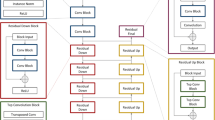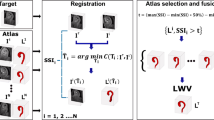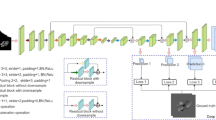Abstract
Objective
Three-dimensional (3D) time-resolved phase-contrast cardiac magnetic resonance (4D flow CMR) allows for unparalleled quantification of blood velocity. Despite established potential in aortic diseases, the analysis is time-consuming and requires expert knowledge, hindering clinical application. The present research aimed to develop and test a fully automatic machine learning-based pipeline for aortic 4D flow CMR analysis.
Methods
Four hundred and four subjects were prospectively included. Ground-truth to train the algorithms was generated by experts. The cohort was divided into training (323 patients) and testing (81) sets and used to train and test a 3D nnU-Net for segmentation and a Deep Q-Network algorithm for landmark detection. In-plane (IRF) and through-plane (SFRR) rotational flow descriptors and axial and circumferential wall shear stress (WSS) were computed at ten planes covering the ascending aorta and arch.
Results
Automatic aortic segmentation resulted in a median Dice score (DS) of 0.949 and average symmetric surface distance of 0.839 (0.632–1.071) mm, comparable with the state of the art. Aortic landmarks were located with a precision comparable with experts in the sinotubular junction and first and third supra-aortic vessels (p = 0.513, 0.592 and 0.905, respectively) but with lower precision in the pulmonary bifurcation (p = 0.028), resulting in precise localisation of analysis planes. Automatic flow assessment showed excellent (ICC > 0.9) agreement with manual quantification of SFRR and good-to-excellent agreement (ICC > 0.75) in the measurement of IRF and axial and circumferential WSS.
Conclusion
Fully automatic analysis of complex aortic flow dynamics from 4D flow CMR is feasible. Its implementation could foster the clinical use of 4D flow CMR.
Key Points
• 4D flow CMR allows for unparalleled aortic blood flow analysis but requires aortic segmentation and anatomical landmark identification, which are time-consuming, limiting 4D flow CMR widespread use.
• A fully automatic machine learning pipeline for aortic 4D flow CMR analysis was trained with data of 323 patients and tested in 81 patients, ensuring a balanced distribution of aneurysm aetiologies.
• Automatic assessment of complex flow characteristics such as rotational flow and wall shear stress showed good-to-excellent agreement with manual quantification.




Similar content being viewed by others
Abbreviations
- 4D flow CMR:
-
Three-dimensional (3D) time-resolved phase-contrast cardiac magnetic resonance imaging
- BAV:
-
Bicuspid aortic valve
- CMR:
-
Cardiac magnetic resonance
- DQN:
-
Deep Q-Network
- HV:
-
Healthy volunteers
- IRF:
-
In-plane rotational flow
- ML:
-
Machine learning
- PCMRA:
-
Phase-contrast-enhanced magnetic resonance angiogram
- RL:
-
Reinforcement learning
- SFRR:
-
Systolic flow reversal ratio
- STJ:
-
Sinotubular junction
- TAV:
-
Tricuspid aortic valve
- WSS:
-
Wall shear stress
References
Guala A, Teixido-Tura G, Dux-Santoy L et al (2019) Decreased rotational flow and circumferential wall shear stress as early markers of descending aorta dilation in Marfan syndrome: a 4D flow CMR study. J Cardiovasc Magn Reson 1:1–11. https://doi.org/10.1186/s12968-019-0572-1
Dux-Santoy L, Guala A, Teixido-Tura G et al (2019) Increased rotational flow in the proximal aortic arch is associated with its dilation in bicuspid aortic valve disease. Eur Heart J Cardiovasc Imaging 20(12):1407–1417
Dux-Santoy L, Guala A, Sotelo J et al (2020) Low and oscillatory wall shear stress is not related to aortic dilation in patients with bicuspid aortic valve. A time-resolved phase-contrast magnetic resonance imaging. Arterioscler Thromb Vasc Biol 40(1):1–11
Guala A, Rodriguez-Palomares J, Galian-Gay L et al (2019) Partial aortic valve leaflet fusion is related to deleterious alteration of proximal aorta hemodynamics. Circulation. 139(23):2707–2709
Bissell MM, Hess AT, Biasiolli L et al (2013 Jul) Aortic dilation in bicuspid aortic valve disease: flow pattern is a major contributor and differs with valve fusion type. Circ Cardiovasc Imaging 6(4):499–507
Guzzardi DG, Barker AJ, Van Ooij P et al (2015) Valve-related hemodynamics mediate human bicuspid aortopathy: insights from wall shear stress mapping. J Am Coll Cardiol 66(8):892–900
Guala A, Rodriguez-Palomares JF, Dux-Santoy L et al (2019) Influence of aortic dilation on the regional aortic stiffness of bicuspid aortic valve assessed by 4-dimensional flow cardiac magnetic resonance. JACC Cardiovasc Imaging 12(6):1020–1029
Ruiz-Muñoz A, Guala A, Rodriguez-Palomares J et al (2022) Aortic flow dynamics and stiffness in Loeys–Dietz syndrome patients: a comparison with healthy volunteers and Marfan syndrome patients. Eur Heart J Cardiovasc Imaging 23(5):641–649
Van Ooij P, Markl M, Collins JD et al (2017) Aortic valve stenosis alters expression of regional aortic wall shear imaging study of 571 subjects. J Am Heart Assoc 6(9):e005959
Soulat G, Scott MB, Allen BD et al (2021) Association of regional wall shear stress and progressive ascending aorta dilation in bicuspid aortic valve. J Am Coll Cardiol Img S1936-878X(21):00510-6
Guala A, Dux-Santoy L, Teixido-Tura G et al (2022) Wall shear stress predicts aortic dilation in patients with bicuspid aortic valve. J Am Coll Cardiol Img 15(1):46–56. https://doi.org/10.1016/j.jcmg.2021.09.023
Loncaric F, Camara O, Piella G, Bijnens B (2021) Integration of artificial intelligence into clinical patient management: focus on cardiac imaging. Rev Esp Cardiol (Engl Ed) 74(1):72–80
Campello M, Gkontra P, Izquierdo C et al (2021) Multi-centre, multi-vendor and multi-disease cardiac segmentation: the M&Ms challenge. IEEE Trans Med Imag 40(12):3543–3554. https://doi.org/10.1109/TMI.2021.3090082
Berhane H, Scott M, Elbaz M et al (2019) Fully automated 3D aortic segmentation of 4D flow MRI for hemodynamic analysis using deep learning. Magn Reson Med 2020:1–15
Ronneberger O, Fischer P, Brox T (2015) U-Net: convolutional networks for biomedical image segmentation. In: Lecture Notes in Computer Science (including subseries Lecture Notes in Artificial Intelligence and Lecture Notes in Bioinformatics), vol 9351, pp 12–20. https://doi.org/10.1007/978-3-319-24574-4_28
Dux-Santoy L, Rodríguez-Palomares JF, Teixidó-Turà G et al (2022) Registration-based semi-automatic assessment of aortic diameter growth rate from contrast-enhanced computed tomography outperforms manual quantification. Eur Radiol 32(3):1997–2009. https://doi.org/10.1007/s00330-021-08273-2
Rodriguez-Palomares J, Dux-Santoy L, Guala A et al (2018) Aortic flow patterns and wall shear stress maps by 4D-flow cardiovascular magnetic resonance in the assessment of aortic dilatation in bicuspid aortic valve disease. J Cardiovasc Magn Reson 20(1):28. https://doi.org/10.1186/s12968-018-0451-1
Gil-Sala D, Guala A, Garcia Reyes ME et al (2021) Geometric, biomechanic and haemodynamic aortic abnormalities assessed by 4D flow cardiovascular magnetic resonance in patients treated by TEVAR following blunt traumatic thoracic aortic injury. Eur J Vasc Endovasc Surg 62(5):797–807. https://doi.org/10.1016/j.ejvs.2021.07.016
Alansary A, Oktay O, Li Y et al (2019) Evaluating reinforcement learning agents for anatomical landmark detection. Med Image Anal 53(Midl):156–164
Mnih V, Kavukcuoglu K, Silver D et al (2015) Human-level control through deep reinforcement learning. Nature. 518(7540):529–533
Ghesu FC, Georgescu B, Zheng Y et al (2019) Multi-scale deep reinforcement learning for real-time 3D-landmark detection in CT scans. IEEE Trans Pattern Anal Mach Intell 41(1):176–189
Ghesu FC, Georgescu B, Mansi T, Neumann D, Hornegger J, Comaniciu D (2016) An artificial agent for anatomical landmark detection in medical images BT - Medical Image Computing and Computer-Assisted Intervention. MICCAI 2016:229–237
Johnson KM, Lum DP, Turski PA, Block WF, Mistretta CA, Wieben O (2009) Improved 3D phase contrast MRI with off-resonance corrected dual echo VIPR. Magn Reson Med 60(6):1329–1336
Yushkevich PA, Piven J, Hazlett HC et al (2006) User-guided 3D active contour segmentation of anatomical structures: significantly improved efficiency and reliability. Neuroimage. 31(3):1116–1128
Isensee F, Jaeger PF, Kohl SAA, Petersen J, Maier-Hein KH (2020) nnU-Net: a self-configuring method for deep learning-based biomedical image segmentation. Nat Methods 18:203–2011
Aviles J, Maso Talou GD, Camara O et al (2021) Domain adaptation for automatic aorta segmentation of 4D flow magnetic resonance imaging data from multiple. In: Functional Imaging and Modeling of the Heart FIMH 2021 Lecture Notes in Comp Sci, pp 112–121. https://doi.org/10.1007/978-3-030-78710-3_12
Bensalah MZ, Bollache E, Kachenoura N et al (2014) Geometry is a major determinant of flow reversal in proximal aorta. Am J Physiol Heart Circ Physiol 306:1408–1416
Hess AT, Bissell MM, Glaze SJ et al (2013) Evaluation of circulation, Γ, as a quantifying metric in 4D flow MRI. J Cardiovasc Magn Reson 15(Suppl 1):E36
Stalder AF, Russe MF, Frydrychowicz A, Bock J, Hennig J, Markl M (2008) Quantitative 2D and 3D phase contrast MRI: optimized analysis of blood flow and vessel wall parameters. Magn Reson Med 60(5):1218–1231
Morales X, Mill J, Delso G et al (2021) 4D flow magnetic resonance imaging for left atrial haemodynamic characterization and model calibration. Vol. 12592 LNCS, Lecture Notes in Computer Science (including subseries Lecture Notes in Artificial Intelligence and Lecture Notes in Bioinformatics). Springer International Publishing, vol 12592, pp 156–165. https://doi.org/10.1007/978-3-030-68107-4_16
Guala A, Teixido-Tura G, Rodriguez-Palomares JF et al (2019) Proximal aorta longitudinal strain predicts aortic root dilation rate and aortic events in Marfan syndrome. Eur Heart J 40(25):2047–2055
Acknowledgements
We are grateful to Hannah Cowdrey for English revision.
Data and models availability statement
The data underlying this article will be shared on reasonable request to the corresponding author. The four trained algorithms for the identification of anatomical landmarks are available at https://github.com/CardiovascularImagingVallHebron/4D_flow_landmark_detection/tree/master/DQN/Models/AORTA.
Funding
This study has been supported by funding from the Instituto de Salud Carlos III (projects PI14/01062, PI17/00381 and PI20/01727), the Spanish Ministry of Science, Innovation and Universities (RTC2019-007280-1 and RTI2018-101193-B-I00), the Spanish Ministry of Economy and Competitiveness (PRE2018-084062), the Spanish Society of Cardiology (SEC/FEC-INV-CLI 20/015 and SEC/FEC-INV-CLI 21/030), the Agency for Management of University and Research Grants of the Generalitat de Catalunya (2020-FI-B-00690) and the Biomedical Research Networking Center on Cardiovascular Diseases (CIBERCV). Guala A. has received funding from Spanish Ministry of Science, Innovation and Universities (IJC2018-037349-I) and from “la Caixa” Foundation (LCF/BQ/PR22/11920008).
Author information
Authors and Affiliations
Corresponding authors
Ethics declarations
Guarantor
The scientific guarantor of this publication is Andrea Guala.
Conflict of interest
The authors of this manuscript declare no relationships with any companies, whose products or services may be related to the subject matter of the article.
Statistics and biometry
Several authors have significant statistical expertise.
Informed consent
Written informed consent was obtained from all subjects (patients) in this study.
Ethical approval
Institutional Review Board approval was obtained.
Methodology
• prospective
• cross-sectional study/diagnostic or prognostic study
• performed at one institution
Additional information
Publisher’s note
Springer Nature remains neutral with regard to jurisdictional claims in published maps and institutional affiliations.
Supplementary Information
ESM 1
(PDF 15 kb)
Rights and permissions
Springer Nature or its licensor holds exclusive rights to this article under a publishing agreement with the author(s) or other rightsholder(s); author self-archiving of the accepted manuscript version of this article is solely governed by the terms of such publishing agreement and applicable law.
About this article
Cite this article
Garrido-Oliver, J., Aviles, J., Córdova, M.M. et al. Machine learning for the automatic assessment of aortic rotational flow and wall shear stress from 4D flow cardiac magnetic resonance imaging. Eur Radiol 32, 7117–7127 (2022). https://doi.org/10.1007/s00330-022-09068-9
Received:
Revised:
Accepted:
Published:
Issue Date:
DOI: https://doi.org/10.1007/s00330-022-09068-9




